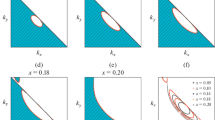Abstract
We present a direct link between manifestations of classical Hamiltonian chaos and quantum nonintegrability effects as they occur in quantum invariants. In integrable classical Hamiltonian systems, analytic invariants (integrals of the motion) can be constructed numerically by means of time averages of dynamical variables over phase-space trajectories, whereas in near-integrable models such time averages yield nonanalytic invariants with qualitatively different properties. Translated into quantum mechanics, the invariants obtained from time averages of dynamical variables in energy eigenstates provide a topographical map of the plane of quantized actions (quantum numbers) with properties which again depend sensitively on whether or not the classical integrability condition is satisfied. The most conspicuous indicator of quantum chaos is the disappearance of quantum numbers, a phenomenon directly related to the breakdown of invariant tori in the classical phase flow. All results are for a system consisting of two exchange-coupled spins with biaxial exchange and single-site anisotropy, a system with a nontrivial integrability condition.
Similar content being viewed by others
References
Lichtenberg, A.J., Lieberman, M.A.: Regular and stochastic motion. Berlin, Heidelberg, New York: Springer 1983
Tabor, M.: Chaos and integrability in nonliner dynamics. New York: Wiley 1989
Sagdeev, R.Z., Usikov, D.A., Zaslavsky, G.M.: Nonlinear physics. From the pendulum to turbulence and chaos. Chur: Harwood 1988
Ozorio de Almeida, A.M.: Hamiltonian systems. Chaos and quantization. Cambridge: Cambridge University Press 1988
Wolfram, S.: Phys. Rev. Lett.55, 449 (1985)
Ford, J.: Phys. Today33, No. 4, 40 (1983)
Chaitin, G.J.: Algorithmic information theory. Cambridge: Cambridge University Press 1987
Chaotic behavior in quantum systems. Theory and applications. Casati, G. (ed.). New York: Plenum Press 1985
Quantum measurement and chaos. Pike, E.R., Sarkar, S. (eds.) New York: Plenum Press 1987
Eckhardt, B.: Phys. Rep163, 205 (1988)
Bohigas, O., Giannoni, M.J., Schmit, C.: Phys. Rev. Lett.52, 1 (1984)
José, J.V.: In: Directions in chaos. Bai-Lin, H. (ed.), Vol. II. Singapore: World Scientific 1989
Van Leeuwen, K.A.H., et al.: Phys. Rev. Lett.55, 2231 (1985)
Bardsley, J.N., et al.: Phys. Rev. Lett.56, 1007 (1986)
Holle, A., et al.: Phys. Rev. Lett.56, 2594 (1986)
Hoffnagle, J., De Voe, R.G., Reyna, L., Brewer, R.G.: Phys. Rev. Lett.61, 255 (1988)
Magyari, E., Thomas, H., Weber, R., Kaufman, C., Müller, G.: Z. Phys. B-Condensed Matter65, 363 (1987)
Srivastava, N., Kaufman, C., Müller, G., Weber, R., Thomas, H.: Z. Phys. B-Condensed Matter70, 251 (1988)
Srivastava, N., Kaufman, C., Müller, G.: J. Appl. Phys.63, 4154 (1988)
Srivastava, N., Kaufman, C., Müller, G.: J. Phys. (Paris) C8, 1601 (1988)
Khinchin, A.I.: Mathematical foundations of statistical mechanics. p. 19. New York: Dover 1949; Abraham, R., Marsden, J.E.: Foundation of mechanics, 2nd Edn., p. 238. Reading: Benjamin Cummings 1985
See Fig. 6 of Ref. 18 for an illustration
This representations of nonanalytic invariants was amply illustrated in Figs. 7 and 8 of Ref. 18,
Peres, A.: Phys. Rev. Lett.53, 1711 (1984)
For the realization (5.15) of the line integral (5.9b), the appropriate choice of linear transformation which accomplishes this forJ z =0 is the following for symmetry classes A1S, A1A, B2S, B2A:J 1=J ′1 +J ′2 −s,J 2=J ′2 −s ifJ ′2 >0;J 1=J ′2 +s,J 2=J ′2 −J ′1 +s ifJ ′2 <0. For symmetry classes B1S, B1A, B3S, B3A interchangeJ 1 andJ 2 in the above expression
Weber, R.: Untersuchungen an klassischen Spinsystemen. Doctoral Thesis, University of Basel 1988, gives an exhaustive discussion of the symmetry properties and eigenvalue degeneracics of the 2-spin model (2.6)
For simplicity we shall continue to refer to any single pattern in the (E<M 2z >)plane as one web even though in some cases it may only appear that way as a result of projection
Chirikov, B.V.: Phys. Rep.52, 263 (1979)
Berman, G.P., Zaslavskii, G.M.: Phys. Lett.61A, 295 (1977)
Berman, G.P., Zaslavskii, G.M., Kolovsky, A.R.:ibid.87A, 152 (1982); Berman, G.P., Kolovsky, A.R.: ibid. Phys. Lett.95A, 15 (1983)
Lin, W.A., Reichl, L.E.: Phys. Rev. A36, 5099 (1987) ibid, Lin, W.A., Reichl, L.E.: Phys. Rev. AA37 3972 (1988)
Srivastava, N., Kaufman, C., Müller, G.: J. Appl. Phys.67, 5627 (1990)
Author information
Authors and Affiliations
Rights and permissions
About this article
Cite this article
Srivastava, N., Müller, G. Quantum and classical spin clusters: disappearance of quantum numbers and Hamiltonian chaos. Z. Physik B - Condensed Matter 81, 137–148 (1990). https://doi.org/10.1007/BF01454225
Received:
Issue Date:
DOI: https://doi.org/10.1007/BF01454225




